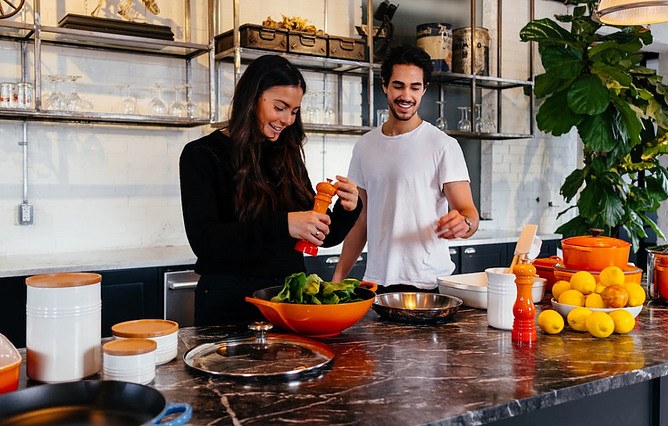When it comes to choosing the right salt for our diets, Kosher salt and Himalayan salt often come into consideration. While they have distinct origins and mineral compositions, both salts share similarities in their sodium content. So, how can you really consider the healthier option out of the two? This comprehensive guide is all about helping you with that decision.
Moderating salt intake is crucial for any individual, especially for those with specific health conditions, such as type 2 diabetes and high blood pressure. In this article, we will also explore the impact of Kosher salt and Himalayan salt on these health conditions, as well as their influence on weight management in individuals with obesity.
Here, our experts will also highlight the importance of overall salt intake moderation, the role of a well-balanced diet and physical activity, and the significance of seeking professional advice for personalized dietary recommendations. By understanding all of these factors, you can make informed choices to promote better health outcomes.
Let’s start the article by defining Kosher Salt – what is it?
What Is Kosher Salt?
Kosher salt gets its name from its use in the koshering process of removing blood from meat, according to Jewish dietary laws. It has a coarse texture and is made by removing impurities from salt brine.
Kosher salt usually does not contain additives like iodine, making it a purer form of salt. It is commonly used in koshering, cooking, and baking.
Now, let’s turn to the popular Himalayan salt.
What Is Himalayan Salt?
Himalayan salt is a type of rock salt that is mined from the Punjab region of Pakistan. It is derived from ancient sea salt deposits and is known for its distinctive pink color, attributed to the presence of trace minerals like iron, magnesium, and potassium.
Himalayan salt is minimally processed and is often marketed as a more natural and healthier alternative to regular table salt.
Now, let’s explore the considerations for individuals with specific health conditions:
How Does Kosher Salt Compare To Himalayan Salt?
Here is a comprehensive list of things in an easy-to-understand table.
|
Aspect |
Kosher Salt |
Himalayan Salt |
|
Source and Origin |
Evaporated sea salt, often with no additives |
Mined from ancient salt deposits in the Himalayan region |
|
Color |
Pure white, uniform granules |
Pink to reddish-pink due to iron minerals |
|
Texture |
Coarse, large grains |
Fine to coarse grains, can vary in texture |
|
Flavor Profile |
Mild, clean saltiness |
Slight mineral flavor, can be less salty |
|
Grain Size |
Coarser, ideal for koshering meat |
Varies, available in fine to coarse grains |
|
Iodine Content |
Typically not iodized |
Naturally low in iodine |
|
Mineral Composition |
Minimal minerals, mainly sodium chloride |
Contains trace minerals (iron, calcium, magnesium, potassium, and others) |
|
Trace Minerals (mg per 1/4 tsp) |
Not specified |
Iron: 0.04 mg (0.0029%), Calcium: 0.03 mg (0.0025%), Magnesium: 0.02 mg (0.0017%), Potassium: 0.02 mg (0.0017%), and others |
|
Processing |
Minimal processing, no additives |
Mined and minimally processed |
|
Use in Cooking |
Widely used in cooking and seasoning |
Versatile, often used as a finishing salt |
|
Cooking Properties |
Easily dissolves, evenly seasons dishes |
Slow to dissolve, provides a subtle crunch |
|
Health Considerations |
No added iodine, suitable for some dietary restrictions |
May offer trace minerals and potentially health benefits |
|
Culinary Applications |
Suitable for general cooking, brining, and curing |
Ideal for enhancing flavors in various dishes |
|
Cost |
Generally more affordable |
Can be relatively more expensive. |
|
Availability |
Widely available in most grocery stores |
Widely available, but may vary by location |
|
Environmental Impact |
Impact varies based on production methods |
Mined from non-renewable Himalayan salt deposits |
|
Usage in Koshering |
Primarily used in koshering meat |
Not typically associated with koshering |
|
Medicinal Claims |
None specific to Kosher Salt |
Some claims of potential health benefits due to trace minerals |
Now, let’s turn into the best salt type for some popular long-term medical conditions…
What Is The Best Salt For Diabetics?
Both Kosher salt and Himalayan salt have a similar sodium content of approximately 2,300 milligrams per teaspoon. For individuals with diabetes, it is crucial to moderate salt intake regardless of the salt type chosen.
The American Diabetes Association (ADA) recommends limiting sodium consumption as part of a balanced diet.
While Himalayan salt is often marketed as a healthier option due to its trace mineral content, the quantities of minerals present in salt are relatively small. Therefore, the overall impact on nutrient intake is unlikely to be significant. Therefore, it’s important to note that the choice between Kosher salt and Himalayan salt does not significantly affect diabetes management.
To effectively manage diabetes, it is essential to adopt a balanced approach to diet and lifestyle, including mindful consideration of salt consumption. The emphasis should be on reducing overall salt intake in accordance with the recommendations from the American Diabetes Association. Both Kosher salt and Himalayan salt have similar sodium content, highlighting the need for moderation in salt consumption.
Generally speaking, individuals with diabetes should prioritize limiting sodium intake, regardless of the type of salt they choose. While Himalayan salt may contain trace minerals, the quantities are not substantial enough to have a significant impact on overall nutrient intake. Achieving optimal diabetes management involves maintaining a balanced diet and lifestyle while being mindful of salt consumption.
Kosher salt is a coarse-grained salt without any additives and is commonly used in cooking and food preparation. It has a comparable sodium content to table salt and a similar impact on blood sugar levels. Therefore, individuals with diabetes should limit their overall salt intake, irrespective of the salt type chosen.
In summary, individuals with diabetes should focus on moderating their salt intake, regardless of whether they opt for Kosher salt or Himalayan salt.
While Himalayan salt may contain trace minerals, their presence does not significantly affect nutrient intake. The key to effective diabetes management lies in maintaining a well-balanced diet and lifestyle while being mindful of salt consumption.
What Is The Best Salt For High Blood Pressure?
High blood pressure is a prevalent health concern, and one of the recommended strategies for managing it is to reduce sodium intake.
The National Institute for Health and Care Excellence (NICE) suggests a maximum daily sodium intake of 2,300 milligrams for adults. In the context of a low-sodium diet aimed at effectively managing blood pressure, both Kosher salt and Himalayan salt should be used sparingly.
While Himalayan salt is often promoted for its trace mineral content, the overall impact on mineral intake is not significant. Therefore, the choice between Kosher salt and Himalayan salt should be based on personal preference rather than specific health considerations for individuals with high blood pressure.
Scientific guidelines confirm that to effectively manage high blood pressure, reducing sodium intake is crucial. Both Kosher salt and Himalayan salt should be used sparingly in a low-sodium diet. The NICE recommends a maximum daily sodium intake of 2,300 milligrams for adults, emphasizing the importance of moderation.
It is essential to note that while Himalayan salt is often touted for its trace mineral content, these quantities are not substantial enough to significantly impact overall mineral intake.
When it comes to choosing between Kosher salt and Himalayan salt in the context of managing high blood pressure, personal preference plays a more significant role than specific health considerations. Both salts can be used sparingly to add flavor to meals, but it is crucial to be mindful of the overall sodium content.
Individuals with high blood pressure should prioritize reducing sodium intake as part of their management strategy.
What Is The Best Salt For Obesity?
Obesity is a complex condition that requires a multifaceted approach for effective management. While reducing salt intake may slightly impact water retention, it is not a primary factor in weight loss.
Instead, focusing on a well-balanced diet, portion control, and regular physical activity are key elements in achieving and maintaining a healthy weight. Therefore, the choice between Kosher salt and Himalayan salt does not significantly impact the management of obesity.
When it comes to addressing obesity, it is important to recognize that excessive salt intake, regardless of the type, can have detrimental effects on health. High sodium consumption has been associated with an increased risk of cardiovascular diseases, such as heart attacks and strokes.
According to the Global Burden of Disease Study, over 1.65 million deaths annually can be attributed to high sodium intake (Mozaffarian et al., 2014). To mitigate these risks, the World Health Organization (WHO) recommends reducing sodium intake to less than 2,000 milligrams per day for adults.
Managing obesity requires a comprehensive approach that goes beyond simply reducing salt intake. While salt reduction may have some impact on water retention, it is not a primary factor in weight loss.
Instead, a well-balanced diet, portion control, and regular physical activity are essential for effective weight management. It is important to note that excessive salt intake, regardless of the type of salt consumed, can have adverse health effects, particularly on cardiovascular health.
To minimize these risks, it is recommended to limit sodium intake to less than 2,000 milligrams per day, as suggested by the World Health Organization.
In addition to the strategies for managing obesity, it is important to adopt a holistic approach that addresses underlying factors contributing to weight gain. This may involve identifying and addressing emotional eating patterns, implementing stress management techniques, and seeking support from healthcare professionals or registered dietitians.
When it comes to salt intake, it is important to be mindful of hidden sources of sodium in processed and packaged foods. These foods often contain high levels of sodium, which can contribute to weight gain and other health issues. Opting for fresh, whole foods and cooking meals at home using minimal salt can help reduce overall sodium intake.
While the choice between Kosher salt and Himalayan salt may not significantly impact obesity management, it is worth noting that Himalayan salt has gained popularity for its trace mineral content and unique flavor. However, the quantities of these minerals are relatively small and unlikely to substantially impact overall nutrient intake or weight loss efforts.
Ultimately, the best approach for managing obesity and promoting overall health is to prioritize a balanced and varied diet, regular physical activity, and sustainable lifestyle habits. This includes monitoring overall calorie intake, making informed food choices, and seeking support from healthcare professionals or registered dietitians who specialize in weight management.
By focusing on these factors and adopting a long-term approach to weight management, individuals can make positive changes that support their overall well-being and help them achieve a healthier weight.
Other Salt Types And Alternatives
Here is the list of alternatives to French Sea Salts and Himalayan Salts.
- Bamboo Salt
- Celtic Sea Salt
- Chicken Salt
- Chinen Salt
- Dead Sea Salt
- Epsom Salt
- French Grey Sea Salt
- Garlic Salt
- Hawaiian Salt
- Himalayan Salt
- Red Salt
- Smoked Salt
In conclusion,
To effectively manage type 2 diabetes and high blood pressure, individuals should use both Kosher salt and Himalayan salt sparingly due to their similar sodium content. The primary focus should be on reducing overall salt intake and adopting a well-balanced diet for improved health outcomes. When it comes to addressing obesity, it is crucial to take a comprehensive approach to weight management rather than solely relying on the choice of salt.
Consulting with healthcare professionals or registered dietitians is always recommended to receive personalized dietary recommendations based on individual health conditions. Moderation is key, and it is beneficial to incorporate a variety of herbs and spices to enhance the flavors of meals without relying heavily on salt.
Moreover, making conscious choices regarding overall dietary patterns and engaging in regular physical activity to maintain optimal health is important. By adopting these practices, individuals can effectively manage their health conditions and promote overall well-being.











Thanks so much for this indebt post, It is so startling when you look at how much salt is consumed. People have the mistaken belief that in order to flavor your foods they need to be highly seasoned which is not true and not good for your health. I have high blood pressure and therefore I myself must watch the amount of salt I consume. Thanks again for an article that is so helpful and the comparison of these two salts.
Dear Norman,
You’re very welcome! We truly appreciate your kind words and your recognition of the importance of understanding salt consumption.
You’re absolutely right; the misconception that highly seasoned food is the only way to enjoy flavorful meals can lead to excessive salt intake, which isn’t conducive to good health. It’s great to hear that you’re conscious of your salt consumption, especially considering your high blood pressure.
Being mindful of your salt intake is a crucial step in managing your health, and it’s commendable that you’re taking that initiative.
We’re delighted that you found the article helpful and that the comparison between Kosher Salt and Himalayan Salt provided valuable insights. If you ever have more questions or need further information about salt, nutrition, or any other health-related topics, please don’t hesitate to ask.
Your health and well-being are important, and we’re here to support you on your journey to better health through informed choices.
Thank you again for your thoughtful comment, and here’s to your continued well-being!